Ford E series
| Ford E series | |
|---|---|
 | |
| Overview | |
| Manufacturer | Ford |
| Production | 1960–2014 (limited beyond 2015, only stripped chassis and cutaway cab in production) |
| Model years | 1961–2014 (limited beyond 2015, only stripped chassis and cutaway cab in production) |
| Assembly | Lorain, Ohio, United States Avon Lake, Ohio, United States Oakville, Ontario, Canada[1] |
| Body and chassis | |
| Class | Full-size van |
| Chronology | |
| Predecessor | Ford F-series panel van |
| Successor | Ford Transit (For United States, Canada, and Mexico) |
The Ford E series (also known as the Ford Econoline and Ford Club Wagon throughout various stages of its production) is a range of full-size vans produced by the American automaker Ford since 1960. Introduced for the 1961 model year as the replacement for the Ford F-series panel van, four generations of the model line have been produced. In addition to cargo van and passenger van body styles, the Ford E series has been produced as a cutaway van chassis and stripped chassis (a chassis without bodywork).
With a 56-year production run, the Ford E series is the second longest-produced nameplate by Ford worldwide; only the Ford F series (1948–present) has been produced longer. For the 2015 model year, the Ford E series cargo/passenger vans were replaced in North America by the Ford Transit introduced worldwide in 2013. As of the 2017 model year, only cutaway and stripped chassis configurations of the E series are produced.
Since 2006, the E series has been assembled at the Ford Motor Company Ohio Assembly plant in Avon Lake, Ohio. From 1961 to 2005, the Ford E series was assembled at Lorain Assembly in Lorain, Ohio.
Prior to its discontinuation, the Ford E-series cargo/passenger van was the best-selling full-size van in the United States since 1980; in 2007, the model held a 79.6% share of the full-size van segment.[2] Commercial or fleet users represented 95% of sales, with cargo vans accounting for nearly half of production.[3]
Contents
1 First generation (1961–1967)
1.1 Chassis
1.2 Body
1.3 Variants
1.3.1 Passenger van
1.3.2 Pickup truck
1.3.3 Mercury Econoline
2 Second generation (1968–1974)
2.1 Chassis
2.2 Body
2.3 Interior
3 Third generation (1975–1991)
3.1 Chassis
3.2 Body
3.3 Interior
4 Fourth generation (1992–2014)
4.1 Chassis
4.2 Exterior
4.3 Interior
5 Sales
6 Phaseout
7 See also
8 References
9 External links
First generation (1961–1967)
| First generation | |
|---|---|
 1961–1967 Ford Econoline (customized) | |
| Overview | |
| Also called | Ford Falcon/Econoline Station Bus Ford Falcon Club Wagon Mercury Econoline (Canada) |
| Production | 1961–1967 |
| Body and chassis | |
| Body style | 4-door panel van 6-door van 8-door van 2-door pickup truck |
| Layout | FMR layout |
| Related | Ford Falcon |
| Powertrain | |
| Engine | 144 cu in (2.4 L) Falcon Six I6 170 cu in (2.8 L) Thriftpower Six I6 240 cu in (3.9 L) Truck Six I6 |
| Transmission | 3-speed manual 4-speed manual 3-speed Cruise-O-Matic automatic |
| Dimensions | |
| Wheelbase | 90.0 in (2,286.0 mm)[4] |
| Length | 168.3 in (4,274.8 mm) 186.3 in (4,732.0 mm) (Econoline Super Van) |
| Width | 75.0 in (1,905.0 mm)[4] |
| Height | 76.9 in (1,953.3 mm)[4] |
The first generation of the Ford Econoline made its debut on September 21, 1960. Introduced for the 1961 model year as a cargo van, pickup truck, and a passenger van (Station Bus/Club Wagon), the Econoline began development based on design sketches that were dated 1957.[5]
While introduced alongside the Chevrolet Corvair van for 1961, the Ford Econoline established many design precedents adopted by successive designs of American vans, including the Chevrolet Van and Dodge A100 (and the European Ford Transit).[6] While remaining a forward-control vehicle, Ford adopted a mid-engine configuration.[7] As the engine was placed between the front seats instead of behind the rear axle as on the Corvair, a larger rear door and flat load floor was created, allowing for additional load capacity.
The first-generation Ford Econoline was produced from 1961 to 1967.
Chassis
In a similar fashion that the Volkswagen Bus (VW Type 2) derived its underpinnings from the Volkswagen Beetle, the first-generation Ford Econoline was based upon the Ford Falcon compact car range. To accommodate its 90-inch wheelbase (the shortest for a Ford since 1908), the Econoline adopted a mid-engine configuration, placing the engine behind the front axle; consequently, the layout precluded the use of a V8 engine.
Initially powered by the 85 hp 144 cubic-inch inline six that was the standard engine of the Falcon, the Econoline was offered with a 101 hp 170 cubic-inch inline-six as an option. In 1965, a 240 cubic-inch inline-six became the optional engine, with the 170 six becoming standard. A three-speed manual was standard, with a Dagenham four-speed manual introduced for 1963 and discontinued in 1964; the 170 cubic-inch engine was offered with a 3-speed automatic in 1964 and the larger two engines were both offered with a 3-speed automatic as an option thereafter. [8]
In contrast to the Falcon, the Econoline was fitted with a solid front axle and a solid rear axle suspension with leaf springs for all four wheels.[9]
Body
In its layout, the Ford Econoline adapted several elements of the Volkswagen Type 2, while making major departures with other design features, with many elements of its design derived from its mid-engine layout. In line with Volkswagen, the Econoline positioned the front seats above the front axle, making it a cabover-style configuration, similar to the Jeep Forward Control. Other elements of its design were borrowed loosely from the Ford Thames 400E produced by Ford of Britain (the predecessor of the Ford Transit), including its grille configuration.
The use of a mid-engine layout enlarged the cargo area, as the engine compartment was relocated forward of the load floor (which was flattened). While Volkswagen would market the Type 2 in the United States until 1979, the configuration of the Econoline was adopted by Chevrolet/GMC in 1964 (replacing the Corvair-based Greenbrier van) and the 1964 Dodge A100.
Through its production, the first-generation Ford Econoline was offered in several variants, with four versions of the cargo van. Along with the 6-door windowless cargo van, Ford introduced an 8-door cargo van in 1963, adding two doors to the driver side. In 1964, a panel van variant was introduced, deleting the side loading doors. Cargo vans (with the exception of the panel van) were offered with or without windows in several configurations.
In 1965, Ford introduced a "Super Van" variant of the Econoline, extending the body 18 inches behind the rear axle.
1963 Ford Falcon Club Wagon
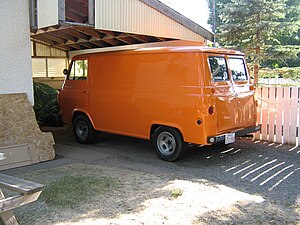
1961-1967 Ford Econoline cargo van (aftermarket wheels)
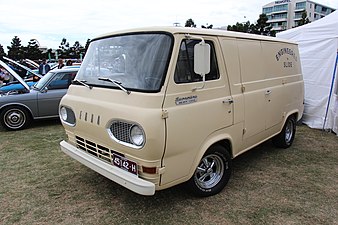
1964 Ford Econoline Heavy Duty cargo van (8-door version)

Ford Econoline TravelWagon (camper interior)
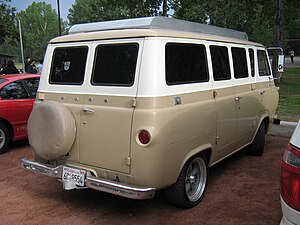
Ford Econoline TravelWagon (camper interior)
Variants
Alongside the Ford Falcon, the Ford Econoline was expanded into a product line including several vehicles. In Canada, the Econoline was marketed through both the sales networks of both Ford and Lincoln-Mercury (as a Mercury), to increase its presence outside of urban areas.
Passenger van
Introduced alongside the cargo van in 1961, Ford introduced two passenger variants of the Econoline (branded as part of the Falcon range) Alongside the Station Bus (branded as both a Falcon and Econoline), Ford marketed the Club Wagon. While the Station Bus was largely intended for commercial/fleet use, the Club Wagon was marketed as an alternative to station wagons.[10] A five-seat configuration was standard, with an eight-seat configuration offered as an option.
Pickup truck
Introduced as part of the Econoline model line for 1961, the Ford Econoline pickup truck was based upon the cargo van. Sharing the forward-control configuration of the Chevrolet Corvair pickup, through its mid-engine chassis, the Econoline pickup truck saw no engine intrusion into the cargo bed. Although, in 1965 with the offering of the larger 240 cubic-inch engine there was a slight intrusion into the cargo bed providing clearance for the larger transmission bellhousing. The Econoline pickup was offered in two window configurations: 3 windows and 5 windows with windows in the rear cab corners to provide better visibility. Early in 1965 the pickup was offered as a Spring Special with a special trim package. While far shorter than an F-100, the pickup was configured with a seven-foot long cargo bed.
The Econoline pickup was only produced during the first generation of production, ending production after the 1967 model year. In 1961, Ford projected the pickup leading the van in sales; however, buyer preferences shifted towards the van configuration, as the pickup accounted for 10% of 1961 Econoline production.[11]

Ford Econoline pickup truck

Rear view, Econoline pickup (Mercury version)
Mercury Econoline
The first-generation Econoline was sold by Ford of Canada by both Ford and Mercury. Alongside the M-series truck line, the Mercury Econoline allowed for Ford of Canada to maximize its presence in rural areas served by either a Ford or a Lincoln-Mercury dealer network, but not both. Largely identical to its Ford counterpart with only minor exceptions of badging, the Mercury Econoline product line was sold as a pickup, cargo van, and passenger van.
In 1961, the pickup truck commenced production at Oakville Assembly in Canada; later that year, Mercury Econoline pickup production shifted to the Lorain, Ohio assembly plant.[12] From 1962 to 1965, Mercury sourced Econoline vans and pickups from Oakville, with all later vehicles imported from the United States.[12]
Production numbers of Mercury Econolines were low; for example, a total of 1,291 Mercury Econoline pickup trucks were built in 1965.[13]
During 1968, Mercury ended its sale of light trucks, discontinuing the M series. Subsequently, the next van sold by Mercury was the 1993 Mercury Villager minivan.
Second generation (1968–1974)
| Second generation | |
|---|---|
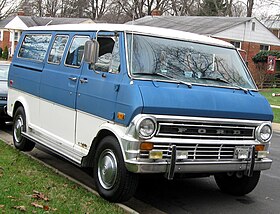 1972–1974 Ford Club Wagon | |
| Overview | |
| Production | 1968–1974 |
| Body and chassis | |
| Body style | 3-door van |
| Layout | FR layout |
| Powertrain | |
| Engine | 240 cu in (3.9 L) I6 300 cu in (4.9 L) I6 302 cu in (5.0) Windsor V8 |
| Transmission | 3-Speed Manual 3-speed Cruise-O-Matic automatic |
| Dimensions | |
| Wheelbase | SWB: 105.5 in (2,679.7 mm) LWB: 123.5 in (3,136.9 mm) |
As the result of a lengthy United Auto Workers strike in 1967, the launch of the second-generation Econoline van was delayed almost four months until January 1968. Instead of calling it a 1968 or 1968.5 model, Ford decided to call it the 1969 model. Shedding its Falcon roots, the second-generation Econoline became a heavier-duty vehicle, sharing many of its underpinnings with the F-series full-size pickups.
Chassis
While the unibody construction of the previous-generation van was carried over, a major change was made in the overall layout in the body and chassis of the Econoline. To build a heavier-duty chassis, the mid-engine forward-control layout was abandoned in favor of a front-engine layout with the axle placed forward; this also allowed the use of the "Twin I-Beam" front suspension used in the F-series trucks. The redesign in the configuration resulted in major growth; the Econoline grew 15 inches in wheelbase; an 18-inch longer long-wheelbase model became the largest full-size van offered in North America at the time.
As they had become introduced as options in Dodge and Chevrolet/GMC vans, Ford introduced a V8 engine option into the powertrain line.
Body
With the change of chassis and axle configurations, the Econoline gained a conventional hood for engine access (though most engine access remained from the interior). To aid in engine compartment ventilation, the model was given a conventional grille, styled similar to the F series.
For 1971, the grille was redesigned to match the updated F series. For 1972, a sliding rear door became an option; introduced on a cutaway van chassis was the Hi-Cube van, a cab-chassis version of the Econoline with a box-van body. The introduction of the cab-chassis variant would become popular in the recreational-vehicle industry (a Class C RV), a segment still dominated by the E series in the 2010s.
Interior
Inside of the Econoline, the shift of the engine location moved the engine housing from between the seats to in front of the driver and front passenger, under the windshield. While the Econoline cargo van remained, it was joined by an Econoline passenger van (replacing the Falcon van). To attract more buyers to passenger vans, Ford introduced two new trims of the passenger van, the Ford Club Wagon and Ford Club Wagon Chateau. Based on the long-wheelbase version, the Chateau had air conditioning, houndstooth fabric on all seats, an AM/FM sound system, and the option of 12-passenger seating.
- Second-generation models 1969–1974

1969-71 Econoline Window Van

1972 Econoline motorhome conversion
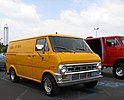
1973 Econoline 100

1974 Ford Econoline E-300 Quadravan
Third generation (1975–1991)
| Third generation | |
|---|---|
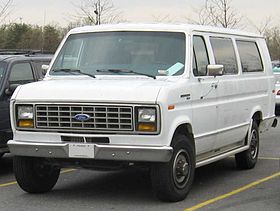 1983–1991 Ford Club Wagon | |
| Overview | |
| Also called | Ford Club Wagon |
| Production | 1975–1991 |
| Body and chassis | |
| Body style | 3-door van |
| Layout | FR layout |
| Platform | Ford VN platform |
| Related | Ford Carousel |
| Powertrain | |
| Engine | 240 cu in (3.9 L) I6 300 cu in (4.9 L) I6 302 cu in (4.9 L) Windsor V8 351 cu in (5.8 L) Windsor V8 460 cu in (7.5 L) 385 V8 6.9 L Navistar diesel V8 7.3 L Navistar diesel V8 |
| Transmission | 3-speed manual 4-speed manual 3-speed automatic 4-speed automatic 5-speed manual |
For 1975, the Econoline/Club Wagon were given a complete redesign. Based on an all-new chassis, Ford became the first American manufacturer to adapt body-on-frame construction to a full-size van.
The new-generation Econoline would become common not only in its own right, but as the basis for other vehicles. With a full frame, the Econoline became popular as a cutaway van chassis; the design served as a basis for many ambulances, and various types of trucks and buses. The shared drivetrain with the F series marked the beginning of aftermarket four-wheel drive conversions. During the 1970s, the Econoline became popular as a basis for van conversions. Using the sparsely-equipped Econoline cargo van as a basis, a luxurious interior was fitted, along with extensive customization of the exterior.
A stillborn variant of the Econoline, the Ford Carousel, nearly reached production as the first American minivan. While a running prototype was produced and planned for a potential 1975-1976 introduction, lack of funding led to the discontinuation of the project.
Chassis
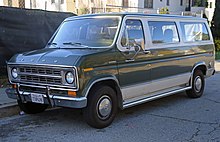
1975-1978 Ford Econoline 150 Chateau

1988 Econoline 350 cutaway van

1980s Ford Club Wagon XLT
To increase the versatility of the full-size van line, the Econoline was developed using body-on-frame construction for the first time. In addition to increasing the strength of the chassis, the configuration allowed more commonality with the F-series trucks. As before, the Twin I-Beam front suspension was used. In its new configuration, the engine was moved further forward and lowered, relative to the body. In a massive growth spurt, the short-wheelbase configuration was 0.5 inches longer than the previous long-wheelbase chassis; the new long-wheelbase chassis was 138 inches, the longest wheelbase full-size van sold until 1990. In 1988, the 124-inch wheelbase was discontinued, leaving the 138-inch wheelbase as standard.
In 1982, to increase the fuel economy of the Econoline without a major loss in engine output, Ford introduced the option of a 6.9L IDI diesel V8 produced by International Harvester; in 1988, this was enlarged to 7.3L. The diesel V8 engines were available only in Econoline 350s (or Club Wagons sold on the same chassis).
Due to the popularity of automatic transmissions in full-size vans, Ford discontinued the 3-speed manual and 4-speed manual transmissions after the 1987 model year.
Body
Unlike its predecessors, Ford designed the 1975 Econoline with a true "two-box" layout. Similar to the Ford Transit of the time, the configuration moved the engine as far forward as possible and lower in the chassis than in its predecessor; although the hood was nearly twice as long, the hoodline was much lower. A higher degree of parts commonality with the F series made itself known in the bodystyling: the vent windows, taillights, bumpers, and wheels were common items between the two vehicles.
During its sixteen-year production run, the exterior of the Econoline/Club Wagon would remain nearly unaltered. In 1978, the Super Van/Super Wagon was introduced; based on the 138-inch wheelbase, it was a rear body extension allowing for extra cargo room or an extra row of seating (for up to 15 passengers). In 1979, a minor facelift updated the grille design; round headlights were replaced by rectangular units. In 1983, the Ford Blue Oval was added to the grille, replacing the "FORD" lettering on the hood.
Although the 1986 Ford Aerostar minivan would introduce styling far different from the Econoline, the basic styling of the full-size van would heavily influence the Ford Ranger (and its SUV offspring, the Ford Bronco II).
Interior
Inside, the redesign of the chassis expanded interior room, though the rear of the engine still remained between the front seats; an engine cover still provided access for servicing. Sharing many controls with the F series, the new design also improved interior ergonomics. In three body sizes, the Econoline was produced in a cargo van and passenger van, with the latter produced in three trim levels; base, Custom and Chateau. In addition, the Club Wagon was produced solely as a passenger van. After 1980, this was replaced by F-series nomenclature of XL and XLT. In line with the F series, the Econoline/Club Wagon was sold in 100/150/250/350 variants, with the Econoline 100 discontinued in 1983 (Club Wagon chassis variants were not denoted).
1975–1991 Ford E-series dimensions[14] | |||
| 124" WB | 138" WB (Standard Van) | 138" WB (Super Van) | |
|---|---|---|---|
| Length | 186.8 in (4,745 mm) | 206.8 in (5,253 mm) | 226.8 in (5,761 mm) |
| Wheelbase | 124 in (3,149.6 mm) | 138 in (3,505.2 mm) | |
| Height | 79.1–79.9 in (2,009.1–2,029.5 mm) | 79.2–84.4 in (2,011.7–2,143.8 mm) | 80.9–84.8 in (2,054.9–2,153.9 mm) |
| Width | 79.9 in (2,029 mm) | ||
Fourth generation (1992–2014)
| Fourth generation | |
|---|---|
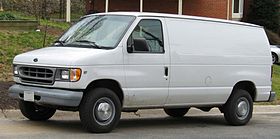 1997–2002 Ford Econoline | |
| Overview | |
| Also called | Ford Econoline (until 2006; name still used in Mexico according to Ford Mexico's website) Ford Club Wagon (until 1998) Ford Econoline Wagon (1999–2005) |
| Production | 1991–2014 (passenger/cargo van) 1991–present (cutaway/stripped chassis) |
| Model years | 1992–2014 (passenger/cargo van) 1992–present (cutaway/stripped chassis) |
| Body and chassis | |
| Body style | 3/4-door van |
| Layout | FR layout |
| Platform | Ford VN platform |
| Powertrain | |
| Engine | 4.9 L (300 cu in) Truck Six I6 4.9 L (302 cu in) Windsor V8 5.8 L (351 cu in) Windsor V8 7.5 L (460 cu in) 385/Lima V8 Navistar 7.3 L IH IDI Diesel V8 Navistar 7.3 L Power Stroke Diesel V8 4.2 L Essex V6 4.6 L Triton V8 5.4 L Triton V8 6.8 L Triton V10 Navistar 365 CID 6.0 L Power Stroke Diesel V8 6.2 L Boss V8 |
| Transmission | 4-speed AOD automatic 5-speed TorqShift automatic 6-speed TorqShift automatic |
| Dimensions | |
| Wheelbase | 138 in (3,505 mm) |
| Length | 1992–2007 Regular: 212 in (5,385 mm) Extended: 232 in (5,893 mm) 2008– Regular: 216.7 in (5,504 mm) Extended: 236.7 in (6,012 mm) |
| Width | 79.3–79.9 in (2,014–2,029 mm) |
| Height | 80.7–84.1 in (2,050–2,136 mm) |
| Curb weight | 4,773 lb (2,165 kg) |
| Chronology | |
| Successor | Ford Transit |
For the first time since 1975, the Ford Econoline was given a major redesign for the 1992 model year. Although the body and interior saw extensive changes, the fleet-oriented Econoline 150/250/350 made its return in both cargo and passenger configurations. For retail markets, the Club Wagon XLT made its return, joined by the luxury-oriented Chateau trim (reviving a trim used in the late 1970s). The Ford Club Wagon Chateau would go on to become the 1992 winner of Motor Trend magazine's Truck of the Year award.
Sold in a single wheelbase with two body lengths, the Econoline/Club Wagon was available in several passenger configurations, seating from 2 to 15 passengers.
For 1999, the Club Wagon name was discontinued, with all Econoline passenger vans sold as Wagons. For 2001, in the United States, the Econoline name was dropped (it was dropped in Canada in 1995), with the Econoline nomenclature being shortened to E-150, E-250, E-350, similar to the F-series nomenclature.
A Special 50th Anniversary version the E series was made in the 2011 model year.[15]
After 2014, the passenger van and cargo van variants of the E series were discontinued in North America in favor of the newly introduced Ford Transit, with production of these variants ending in June 2014. However, cutaway cab and stripped-chassis variants remained in production for 2015 and will be built "until the end of the decade", according to Ford.[16]
Chassis
While the body and interior saw massive changes, to lower development costs, Ford retained the existing VN platform that had underpinned the Econoline/Club Wagon. Sharing many components with the F-series trucks, the E series maintained the "twin I-beam" front suspension common to nearly all rear-wheel drive Ford trucks in North America. The rear suspension consisted of a live rear axle with rear leaf springs.
In 1992, the powertrain line was largely carried over; the E series was equipped with the 300 CID (4.9L) inline-six as a base engine with an option of three gasoline V8s: 302 cu in (4.9 L), 351 cu in (5.8 L), and a 460 cu in (7.5 L)). A T444E with 444 cu in (7.3 L) diesel V8 sourced from Navistar was also available, and offered with an optional turbocharger starting in 1993. In mid-year 1994, the 444 cu in (7.3 L) IDI diesel was replaced by a 444 cu in (7.3 L) Ford Powerstroke diesel, also sourced from Navistar.
For 1997, nearly the entire engine line was replaced, with only the 7.3L Powerstroke diesel remaining. A 4.2L Essex V6 replaced the 4.9L inline-6 and the 7.5L V8 was replaced by a 6.8L Triton V10. The 302 cu in (4.9 L) and 351 cu in (5.8 L) Windsor V8s were replaced by 4.6L and 5.4L Triton V8s, respectively.
During the 2003 model year, the 7.3L Powerstroke diesel was replaced by a 6.0L Powerstroke diesel, again sourced by Navistar; due to the lack of airflow in the engine compartment compared to the Ford Super Duty trucks, the version used in the E series required to be slightly detuned. In contrast to the 7.3L V8, the 6.0L Powerstroke is intercooled.
For 2004, the 4.2L V6 was dropped from the E150 and E250, with the 4.6L V8 becoming the base engine; for the first time in its production, the base engine for all E-series models was a V8 (a first in American full-size vans). Output of the 6.8L Triton V10 was increased to 305 hp (227 kW; 309 PS) and 420 lb·ft (569 N·m) torque, and to 235/440 for the 6.0L diesel. The E150 also received standard 4-wheel disk brakes.
As part of the 2008 update of the E series, the chassis underwent several updates. Although the Twin I-Beam front suspension was carried over (becoming one of two Ford vehicle to use the system, other is superduty chassis), other upgrades to the braking, suspension and steering systems improved ride and handling, braking performance and load carrying capability.[17] A properly equipped E350 would have a maximum gross vehicle weight rating (GVWR) of 9,900 lb (4490 kg) and be able to tow 10,000 lb (4536 kg).[18]
In 2009, Ford began offering E-series models capable of using E85; it was available with the 4.6L and 5.4L engines.
Following the introduction of the 6.4L Powerstroke V8 in the Ford Super Duty trucks in 2008, the diesel engine option was discontinued in the E series. According to Ford the primary reason is due to space limitations.[19] It was unconfirmed whether this means the engine physically does not fit or there is not enough space to allow for proper ventilation.
In 2017, the 6.2L Boss V8 replaced the 5.4L Triton V8.[20]
| Engine | Configuration | Production | Transmission |
|---|---|---|---|
| Ford Truck Six | 4.9 L (300 cu in) OHV I6 | 1992-1996 | 4-speed AOD automatic 4-speed E4OD automatic 4-speed 4R100 automatic 5-speed 5R110W automatic (TorqShift) 6-speed automatic (TorqShift) |
| Ford Windsor V8 | 4.9 L (302 cu in) OHV V8 | 1992-1996 | |
| 5.8 L (351 cu in) OHV V8 | 1992-1996 | ||
| Ford 385 V8 | 7.5 L (460 cu in) OHV V8 | 1992-1996 | |
| Navistar 7.3L IDI V8 | 7.3 L (444 cu in) OHV V8 diesel | 1992 | |
| 7.3 L (444 cu in) OHV V8 turbodiesel | 1993 | ||
| Navistar T444E V8 (Ford PowerStroke) | 7.3 L (444 cu in) OHV V8 turbodiesel | 1994-2003 | |
| Ford Essex V6 | 4.2 L (256 cu in) OHV V6 | 1997-2003 | |
| Ford Triton V8 | 4.6 L (281 cu in) SOHC 2V V8 | 1997-2014 | |
| 5.4 L (330 cu in) SOHC 2V V8 | 1997-2016 | ||
| Ford Triton V10 | 6.8 L (413 cu in) SOHC 2V V10 | 1997- | |
| Ford Boss V8 | 6.2 L (379 cu in) SOHC 2V V8 | 2017- |
Exterior
While using the same two-box layout and proportions, the 1992 redesign of the E series was given a far more aerodynamic body than its predecessor. Although Ford used the longest forward body of any full-size van, the hood was angled downward slightly and the windshield raked back; if specified, all side window glass was flush-mounted. For the first time, the E series used flush-mounted wraparound taillights and flush-mounted headlights (the latter were an option, standard on Club Wagons). In addition, the E series was the first full-size van to use a center-mounted brake light.
For 1995, a minor change was made as the amber turn signals were removed from the taillights.
For 1997, a minor facelift involved the grille; to keep in line with other Ford products, the eggcrate grille was replaced by an eight-hole grille with an oval cutout (combining the styling of both Ford cars and trucks).
For 2002, a heavy-duty E-550 variant was introduced. Sharing components with the Super Duty, the E-550 also had a unique front fascia with a larger bumper and grille. Similar to the Super Duty trucks, the Ford emblem was centered in a 3-slot grille in between two openings. High-end trim levels received a chrome grille with a chrome bumper, while the plastic grille, bumper, and sealed-beam headlight housings on low-end trims were now molded in a dark gray color.
For 2003, another facelift updated the rest of the E-series lineup with the same grille as the E-550. During this model year, the front turn signal housings became completely amber.
For 2004, the E-550 was discontinued. Another minor facelift updated the front bumper with three additional openings added below the large opening.
For 2008, the E series was given a major exterior redesign forward of the windshield, with new fenders, hood and a larger grille, similar in a style to both the Super Duty trucks and the 1979-1991 Econolines.
Interior
When redesigning the interior of the E series for 1992, Ford chose to modernize the driver compartment of the vehicle. Sharing its controls and components with the Ford F series and Aerostar, the E-series/Club Wagon was notable for being the first full-size van equipped with a driver's side airbag as standard equipment (on all models except the Econoline 350). While the front engine cover still dominated the space between the front seats, part of the redesign freed up additional passenger room. The instrument panel had a small LCD digital odometer.
For 1994 model year vehicles, air-conditioning systems were converted to CFC-free R134a refrigerant beginning with September 1993 production.
For 1997, the entire drivers' compartment was redesigned. In addition to a smaller engine cover, a more ergonomic dashboard was added; dual airbags were added to all models, replacing the "brick"-style steering wheel. The instrument panel was also changed although the odometer became analogue.
For 2001, the E-150 Traveler was launched, partially intended as a successor to the previous Club Wagon and Chateau models; due to the adoption of minivans and SUVs for family vehicles, it was sold only for 2001.
For 2003, coinciding with the exterior facelift, the interior received a new engine cover with redesigned cup holders. For the first time since 1974, the E series was given a glove box, shared with the Super Duty trucks. For 2004, the instrument panel was given a digital odometer, last used in 1996, certain versions were available with a tachometer.
For 2009, the dashboard was completely redesigned, with only the steering column carried over. Designed to share components with the Super Duty trucks, the E series now comes with the Ford Sync system, in-dash navigation as an option, and integrated auxiliary switches. The glovebox was relocated from the engine cover to forward of the passenger seat. Another option first introduced on the vehicle is a rear-view backup camera; widely available on smaller vehicles, it is the first in the full-size van segment.
For 2021, Ford unveiled a refreshed E-Series Cutaway Van. The new E-Series Cutaway Van will feature an all-new interior inspired by the Ford Super Duty, and will offer new features, including an all-new 7.3L gasoline V8 engine to replace the existing 6.8L Triton V10 gasoline unit, a new steering wheel design, revised instrument cluster with a seven-inch (7.0") color LCD productivity screen, and a newly-standard A/M-F/M audio system with Bluetooth hands-free phone capabilities and USB inputs. Despite major interior changes for the E-Series, the exterior remains largely unchanged. The new E-Series Cutaway Van will be available in 2020 as an early 2021 model year vehicle. [21]
- Fourth-generation Ford E-series / Econoline models (1997–2015)

A circa 1992–1994 Ford Club Wagon passenger van, from Maryland. This particular version can seat up to fifteen passengers.

A circa 1995–1996 Ford E-350 school bus from Quebec, Canada. The body is manufactured by the Corbeil Bus Corporation.

A 2002 E-350 Box Truck outfitted as a disaster restoration vehicle from Bennington, New Hampshire
A circa 2003–2005 Ford E-350 cutaway box truck van, from Quebec, Canada.

A circa 2008 Ford E-250 cargo van, photographed in Queens, New York.

A circa 2010 Ford E-450 powered by compressed natural gas, used as public transportation in Atlantic City, New Jersey.

A 2014 model year E350 "Cutaway" had a contractors-type body manufactured by Rockport.

Pre and post-refresh fourth-generation models side-by-side photographed in Granite City, Illinois.
Sales
| Calendar year | US sales |
|---|---|
| 1997 | 186,690[22] |
| 1998 | 206,026[23] |
| 1999 | 202,024[24] |
| 2000 | 187,027 |
| 2001 | 159,565 |
| 2002 | 165,085[25] |
| 2003 | 161,721 |
| 2004 | 171,017[26] |
| 2005 | 179,543 |
| 2006 | 180,457 |
| 2007 | 168,722 |
| 2008 | 124,596 |
| 2009 | 85,735 |
| 2010 | 108,258 |
| 2011 | 116,874 |
| 2012 | 122,423 |
| 2013 | 125,356[27] |
| 2014 | 103,263[28] |
| 2015 | 50,788[29] |
| 2016 | 54,245[29] |
| 2017 | 53,304[30] |
| 2018 | 47,936[31] |
Phaseout
As part of the OneFord plan[32], the Ford Transit was introduced for sale in North America for the first time for the 2015 model year, replacing the E-series passenger and cargo vans in the United States and Canada. Although the Transit was also introduced in cutaway and chassis-cab configurations for North America as well, Ford has continued commercial production of the E series in cutaway cab and stripped chassis configuration; no planned date is set for the end of production.[16][33]
In Mexico, the E series has been entirely replaced by the Ford Transit in 2015, but the Diesel versions follow the European specifications with the 2.2L 4-cylinder engine and a 6-speed manual transmission instead of the 3.2L 5-cyl and automatic transmission used in the United States and Canada. Gasoline-powered versions retain the automatic transmission standard, but are only available with the naturally-aspirated 3.7L Ti-VCT V6.[citation needed]
See also
- Ford VN platform
References
^ "Plant Information: Oakville Assembly Complex". Media.ford.com. Archived from the original on June 14, 2010. Retrieved May 31, 2011..mw-parser-output cite.citation{font-style:inherit}.mw-parser-output .citation q{quotes:"""""""'""'"}.mw-parser-output .citation .cs1-lock-free a{background:url("//upload.wikimedia.org/wikipedia/commons/thumb/6/65/Lock-green.svg/9px-Lock-green.svg.png")no-repeat;background-position:right .1em center}.mw-parser-output .citation .cs1-lock-limited a,.mw-parser-output .citation .cs1-lock-registration a{background:url("//upload.wikimedia.org/wikipedia/commons/thumb/d/d6/Lock-gray-alt-2.svg/9px-Lock-gray-alt-2.svg.png")no-repeat;background-position:right .1em center}.mw-parser-output .citation .cs1-lock-subscription a{background:url("//upload.wikimedia.org/wikipedia/commons/thumb/a/aa/Lock-red-alt-2.svg/9px-Lock-red-alt-2.svg.png")no-repeat;background-position:right .1em center}.mw-parser-output .cs1-subscription,.mw-parser-output .cs1-registration{color:#555}.mw-parser-output .cs1-subscription span,.mw-parser-output .cs1-registration span{border-bottom:1px dotted;cursor:help}.mw-parser-output .cs1-ws-icon a{background:url("//upload.wikimedia.org/wikipedia/commons/thumb/4/4c/Wikisource-logo.svg/12px-Wikisource-logo.svg.png")no-repeat;background-position:right .1em center}.mw-parser-output code.cs1-code{color:inherit;background:inherit;border:inherit;padding:inherit}.mw-parser-output .cs1-hidden-error{display:none;font-size:100%}.mw-parser-output .cs1-visible-error{font-size:100%}.mw-parser-output .cs1-maint{display:none;color:#33aa33;margin-left:0.3em}.mw-parser-output .cs1-subscription,.mw-parser-output .cs1-registration,.mw-parser-output .cs1-format{font-size:95%}.mw-parser-output .cs1-kern-left,.mw-parser-output .cs1-kern-wl-left{padding-left:0.2em}.mw-parser-output .cs1-kern-right,.mw-parser-output .cs1-kern-wl-right{padding-right:0.2em}
^ "Crossovers, Lincoln highlight Ford's 2007 sales performance; further growth expected in 2008". Media.Ford.com. January 3, 2009. Archived from the original on May 25, 2011.
^ "Ford Introduces The New 2008 E-Series Van". BlueOvalNews. March 7, 2007.
^ abc "1963 Ford Falcon Van brochure". Oldcarbrochures.com. Retrieved February 6, 2014.
^ Lee, Peter (2015). Ford Transit: Fifty Years. Crowood. ISBN 9781847978745. Retrieved 29 February 2016.
^ Statham, Steve (1995). Ford Pickup Trucks. Motorbooks. pp. 71–72. ISBN 9780879389871. Retrieved 29 February 2016.
^ Gunnell, John. American cars of the 1960s. 2005. p. 212. ISBN 9780896891319. Retrieved 29 February 2016.
^ "Econoline Transmissions". econoline.org.
^ "Directory Index: FMC Trucks-Vans/1961_Trucks-Vans/1961_Ford_Econoline_Van_Brochure". www.oldcarbrochures.com. Retrieved 2018-04-17.
^ "Directory Index: FMC Trucks-Vans/1963_Trucks-Vans/1963_Ford_Falcon_Van_Brochure". www.oldcarbrochures.com. Retrieved 2018-04-17.
^ Ernst, Kurt (19 January 2014). "Hemmings Find of the Day – 1961 Ford Econolpne pickup". Hemmings. Retrieved 29 February 2016.
^ ab Truesdell, Rich (November 3, 2014). "Mercury Trucks Dare to Be Different". Vintage truck magazine. Archived from the original on 17 April 2018. Retrieved 29 February 2016.
^ "1965 Mercury Econoline pickup truck for sale". American Dream Cars. Retrieved 29 February 2016.
^ "1980 Ford Econolpne Van". Oldcarbrochures.com. Retrieved February 6, 2014.
^ "Ford's E-Series Vans Celebrate 50 Years of Success; 2011 lineup features special anniversary edition". Media.ford.com. September 13, 2010. Archived from the original on September 12, 2011. Retrieved May 31, 2011.
^ ab Jonathon Ramsey (April 18, 2014). "Ford E-series chassis cabs and cutaways to survive mass transit onslaught". autoblog.com. Retrieved October 28, 2014.
^ "Ford Rolls Out Super Duty-Inspired 2008 E-Series Vans". Edmunds Inside Line. March 9, 2007. Archived from the original on March 20, 2007.
^ "6.0 and 6.4 Liter Power Stroke Direct Injection Turbo Diesel Owner's Guide Supplement" (PDF). Ford Motor Company. p. 16. Retrieved 28 February 2019.
^ Ford Power Stroke engine
^ "New ergonomic and tech options enhance 2017 Ford Transit lineup; new engine for E-series stripped chassis, cutaway". Ford Motor Company Media Center. March 1, 2016.
^ http://fordauthority.com/2019/03/new-2021-ford-e-series-chassis-cab-debuts/
^ "Ford Reports Detailed Sales Results". www.theautochannel.com. Retrieved 31 July 2017.
^ Company, Ford Motor. "Ford Motor Company Topples December and Full Year U.S. Sales Records". www.prnewswire.com. Retrieved 31 July 2017.
[better source needed]
^ "Ford Motor Company Sets New Full Year U.S. Sales Record". Theautochannel.com. Retrieved April 28, 2009.
^ "Ford's F-Series Truck Caps 22nd Year in a Row as America's Best-Selling Vehicle With a December Sales Record". Theautochannel.com. November 17, 2004. Retrieved April 28, 2009.
^ "Ford Achieves First Car Sales Increase Since 1999". Theautochannel.com. November 17, 2004. Retrieved April 28, 2009.
^ "Ford Motor Company Delivers Best Sales Year Since 2006; Ford Is Top Brand with Records for Fiesta, Fusion, Escape" (Press release). USA: Ford. January 3, 2014. Retrieved January 10, 2014.
^ "Ford Posts Best U.S. December Sales Results since 2005; Ford Once Again Best-Selling Brand and Best-Selling Vehicle" (Press release). USA: Ford. January 5, 2015. Retrieved February 12, 2015.
^ ab "Ford U.S. December Retail Sales up 5 Percent - a 12-Year High; Ford America's Best-Selling Brand for Seventh Year" (Press release). USA: Ford. January 4, 2017. Retrieved August 10, 2017.
^ https://media.ford.com/content/dam/fordmedia/North%20America/US/2018/01/03/dec17-sales.pdf
^ "Ford E-Series Sales Numbers, Figures, Results". Ford Authority.
^ "Ford's Transit Van continues E-Series' success". Detroit News.
^ "Ford Will Continue E-Series Cutaway/Stripped Chassis - PickupTrucks.com News". news.pickuptrucks.com. Retrieved 2016-06-22.
External links
| Wikimedia Commons has media related to Ford E-Series. |
- Ford E-Series official websites: U.S.A. | Canada
- Ford E-Series Ambulance Packages official websites (U.S.A.): Van | Cutaway Chassis
Vintage Truck Magazine 1962 Ford Econoline Van detailed article- Ford Vans E series
Mark's Econoline Page (Mainly about the 1961–1967 Econoline Pickups)- Debut: 2008 Ford E-Series Vans (TheMustangNews.com – March 2007)
- 1968–74 Ford Van Site
- Ford Econoline in television and film
camperize.com—info about converting the E series into a campervan
ThorMotorCoach.com—Major converter of E-series chassis into motorhomes
« previous — Ford Motor Company light truck timeline, North American market, 1946–1979 — next » | ||||||||||||||||||||||||||||||||||
|---|---|---|---|---|---|---|---|---|---|---|---|---|---|---|---|---|---|---|---|---|---|---|---|---|---|---|---|---|---|---|---|---|---|---|
Type | 1940s | 1950s | 1960s | 1970s | ||||||||||||||||||||||||||||||
| 6 | 7 | 8 | 9 | 0 | 1 | 2 | 3 | 4 | 5 | 6 | 7 | 8 | 9 | 0 | 1 | 2 | 3 | 4 | 5 | 6 | 7 | 8 | 9 | 0 | 1 | 2 | 3 | 4 | 5 | 6 | 7 | 8 | 9 | |
SUV | Bronco | Bronco | ||||||||||||||||||||||||||||||||
Coupé utility | Ranchero | Ranchero | Ranchero | Ranchero | Ranchero | Ranchero | Ranchero | |||||||||||||||||||||||||||
Compact pickup | Courier | Courier | ||||||||||||||||||||||||||||||||
Full-size pickup | Standard/ Deluxe | F-Series | F-Series | F-Series | F-Series | F-Series | F-Series | |||||||||||||||||||||||||||
Van | Econoline | Econoline | Econoline / Club Wagon | |||||||||||||||||||||||||||||||
« previous — Ford Motor Company light truck timeline, United States & Canada, 1980s–present | |||||||||||||||||||||||||||||||||||||||||
|---|---|---|---|---|---|---|---|---|---|---|---|---|---|---|---|---|---|---|---|---|---|---|---|---|---|---|---|---|---|---|---|---|---|---|---|---|---|---|---|---|---|
Type | 1980s | 1990s | 2000s | 2010s | |||||||||||||||||||||||||||||||||||||
| 0 | 1 | 2 | 3 | 4 | 5 | 6 | 7 | 8 | 9 | 0 | 1 | 2 | 3 | 4 | 5 | 6 | 7 | 8 | 9 | 0 | 1 | 2 | 3 | 4 | 5 | 6 | 7 | 8 | 9 | 0 | 1 | 2 | 3 | 4 | 5 | 6 | 7 | 8 | 9 | ||
Crossover | Subcompact | EcoSport | |||||||||||||||||||||||||||||||||||||||
| Compact | Escape | Escape | Escape | ||||||||||||||||||||||||||||||||||||||
| Mid-size | Edge | Edge | |||||||||||||||||||||||||||||||||||||||
| Full-size | Freestyle | Taurus X | Explorer | ||||||||||||||||||||||||||||||||||||||
Flex | |||||||||||||||||||||||||||||||||||||||||
SUV | Compact | Bronco II | |||||||||||||||||||||||||||||||||||||||
Mid-size | Explorer | Explorer | Explorer | Explorer | |||||||||||||||||||||||||||||||||||||
Full-size | Bronco | Bronco | Bronco | Expedition | Expedition | Expedition | Expedition | ||||||||||||||||||||||||||||||||||
Excursion | Expedition EL/Max | Expedition Max | |||||||||||||||||||||||||||||||||||||||
Pickup truck | Coupé utility | Durango | |||||||||||||||||||||||||||||||||||||||
Compact | Courier | Ranger | Ranger | Ranger | |||||||||||||||||||||||||||||||||||||
Mid-size | Explorer Sport Trac | Explorer Sport Trac | Ranger | ||||||||||||||||||||||||||||||||||||||
Full-size | F-Series (all) | F-Series (all) | F-Series (all) | F-150/F-250 | F-150 | F-150 | F-150 | ||||||||||||||||||||||||||||||||||
SVT Lightning | SVT Lightning | SVT Raptor | Raptor | ||||||||||||||||||||||||||||||||||||||
Super Duty | Super Duty | Super Duty | Super Duty | ||||||||||||||||||||||||||||||||||||||
Van | Compact MPV | Transit Connect | Transit Connect | ||||||||||||||||||||||||||||||||||||||
C-MAX | |||||||||||||||||||||||||||||||||||||||||
Minivan | Aerostar | Aerostar | |||||||||||||||||||||||||||||||||||||||
Windstar | Windstar | Freestar | |||||||||||||||||||||||||||||||||||||||
| Full-size | Econoline | Econoline/E-Series | |||||||||||||||||||||||||||||||||||||||
Transit | |||||||||||||||||||||||||||||||||||||||||

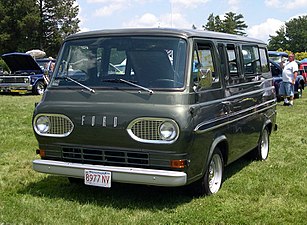


















Comments
Post a Comment